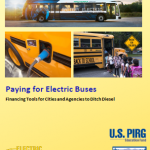Paying for Electric Buses
Financing Tools for Cities and Agencies to Ditch Diesel
Most of America’s school and transit buses run on diesel, a highly-polluting fuel, but there is a better option. All-electric buses are here, and they’re cleaner, healthier and save money for transit agencies, school districts and bus contractors to run in the long-term.
Downloads
U.S. PIRG Education Fund

Most of America’s school and transit buses run on diesel, a highly-polluting fuel, but there is a better option. All-electric buses are here, and they’re cleaner, healthier and save money for transit agencies, school districts and bus contractors to run in the long-term.
Diesel is internationally recognized as a dangerous carcinogen, and diesel exhaust contributes to several respiratory illnesses, including asthma. Children are particularly susceptible to the negative health effects of diesel exhaust because their lungs are still developing. Transportation is also the largest source of greenhouse gas emissions in the country, with heavy-duty vehicles including buses playing a major role in the problem.
Yet every day, our citizens, including commuters and school children, are forced to breath these toxic fumes. Switching to electric buses with zero tailpipe emissions significantly reduces exposure to the localized pollutants. Electric buses are also much cleaner than their diesel or natural gas counterparts. Replacing all of America’s dirty diesel buses, both transit and school buses, with clean electric buses would avoid an average of 7.3 million tons of greenhouse gas emissions annually.
In addition to the public health and environmental benefits, school districts and transit agencies also see cost savings due to the reduced fuel and maintenance costs of electric buses. While electric transit buses costs around $200,000 more than diesel buses, lifetime fuel and maintenance savings of electric transit buses are around $400,000. And while electric school buses cost around $120,000 more than diesel school buses, lifetime fuel and maintenance savings of electric school buses are around $170,000.
Electric buses are available and able to handle many bus routes in the United States. In 2017, 568 electric transit buses were on the road in the U.S., servicing some of the largest public transit agencies in the country. That number continues to grow. Electric school buses are available as well. California’s fleet has grown to over 150 and electric school buses are on the road in Massachusetts, New York, and Minnesota. Several of the major school bus manufacturers already have electric bus models ready, and others have announced models that will be available in 2019.
To clean our air and protect our health, cities, transit agencies and school districts should commit to transitioning to 100% all electric buses by 2030, and immediately begin to implement a plan to phase out the purchase of new diesel buses. As more and more places make these commitments, the electric bus market wll only continue to grow and become more competitive. The technology will continue to advance, and prices will continue to come down.
Still, the upfront purchase price of electric buses is often cited as a hurdle to a swift transition. Although electric buses can save money over their lifetime, they currently cost more to buy than diesel buses do. However, a review of available financing and funding choices reveals that American cities and school districts have a plethora options to make the transition to electric buses feasible.
Transit agencies and school districts may be able to use traditional funding and financing mechanisms to pay for electric buses, such as municipal bonds and local option transportation taxes. Municipal bonds can used by municipalities, transit agencies, or school districts to pay for large capital transit and school projects.
Agencies and school districts can also use vehicle-to-grid technology to offset the costs of electric buses. This is particularly valuable for school buses. When equipped with vehicle-to-grid technology, electric buses can use their batteries for energy storage, providing a service to the grid by reserving and selling electricity back at times of high demand.
Additionally, bus operators can seek out the multitude of grant and incentive programs available for the purchase of electric buses, as well as partner with utilities for beneficial rate programs or infrastructure investments. For instance: In Massachusetts, Pioneer Valley Transit Authority and Martha’s Vineyard Transit Authority are both using Volkswagen settlement funds to purchase electric buses. Twin Rivers Unified School District in California secured a $1 million investment in charging infrastructure from the local utility. Chicago, through the federally funded Drive Clean Chicago program, has made $10 million available for the purchase of electric buses and trucks.
It is time for both transit agencies and school districts to make the switch to electric buses. Electric buses are better for our health, for our planet, and they provide operators with year to year and lifetime financial benefits. Transit agencies and school districts that want to make the switch to electric buses have a plethora of options to help overcome the initial purchase price, it is time that they use them.
To accelerate the adoption of electric buses, we recommend that:
-
Cities, transit agencies, and school districts commit to transitioning to 100% all-electric buses by 2030, with a plan to phase out the purchase of new diesel buses immediately.
-
Cities, transit agencies, and school districts use traditional financing methods like municipal bonds and local option transportation taxes to finance the purchase of new electric buses.
-
Cities, transit agencies, and school districts partner with local utilities to obtain beneficial rate structures to help save on charging costs and work with utilities to secure charging infrastructure investments.
-
Cities, transit agencies, and school districts take advantage of existing federal, regional, state, and local grant and incentive programs to lower the initial purchase price of electric buses.
- States increase funding available for the purchase of electric buses through new grant and incentive programs, like CARB’s grant and incentive programs, and explore using a cap-and-trade policy to generate revenue for clean transportation.